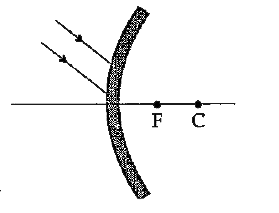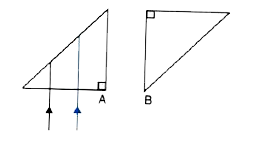In the following figures, one les is places inside each box. State the nature of the lens. Complete the ray diagrams.


In figure (a), the incident rays are diverged after refraction, so the lens is concave. In figure (b), the incident rays are converged after refraction , so the lens is convex.
Topper's Solved these Questions
- LIGHT-REFLECTION AND REFRACTIONBOOK - VK GLOBAL PUBLICATIONCHAPTER - LIGHT-REFLECTION AND REFRACTIONEXERCISE - SOME IMPORTANT NUMERICALS (FOR PRACTICE)
19 Videos
- LIGHT-REFLECTION AND REFRACTIONBOOK - VK GLOBAL PUBLICATIONCHAPTER - LIGHT-REFLECTION AND REFRACTIONEXERCISE - PROFICIENCY EXERCISE (Short Answer Questions-I)
1 Videos
- LIGHT-REFLECTION AND REFRACTIONBOOK - VK GLOBAL PUBLICATIONCHAPTER - LIGHT-REFLECTION AND REFRACTIONEXERCISE - SOME IMPORTANT NUMERICALS
31 Videos
- ELECTRICITYBOOK - VK GLOBAL PUBLICATIONCHAPTER - ELECTRICITYEXERCISE - SOME IMPORTANT NUMERICALS
12 Videos
- MAGNETIC EFFECTS OF ELECTRIC CURRENTBOOK - VK GLOBAL PUBLICATIONCHAPTER - MAGNETIC EFFECTS OF ELECTRIC CURRENTEXERCISE - HOTS (Higher Order Thinking Skills)
22 Videos
Similar Questions
"A lens can form a magnified erect image as well as magnified inverted image of an object placed in front of it." State the nature of this lens and draw ray diagrams to justify the above statement. Mark the positions of O, F and 2F in the diagram.
View SolutionComplete the ray diagram as shown to show the formation of image for parallel rays incident on a convex mirror. State the position, nature and size of the image formed.

View Solution
Knowledge Check
An optical instrument is placed inside the box as shown below. The incident rays and emergent rays are also shown. The optical instrument could be _______.
 Aonly a plane mirrorBonly a convex mirrorConly a concave mirrorDboth plane mirror and convex mirror
Aonly a plane mirrorBonly a convex mirrorConly a concave mirrorDboth plane mirror and convex mirror
(a) Figure shows two isosceles right angled prisms A and B and the light rays incident on the prism A. complete the diagram to show the rays emerging out of the prism B.
(b) State the principle used for completing the ray diagram in part (a) above.

View Solutiona) What type of lens is shown in the diagram on the right? What will happen to the parallel rays of light? Show by completing the ray diagram.
b) Your eye contains a convex lens. Why is it unwise to look at the sun?

View SolutionComplete the following ray diagrams. State the size and nature of image formed in each case.

View SolutionFigure alongside shows an equilateral prism ABC and the ray QR emerging out from the prism after suffering minimum deviation. Complete the diagram to show the refracted ray PQ inside the prism and the incident ray OP on the prism. State in words how have you completed the diagram to show the refracted ray PQ inside the prism and the incident ray OP on the prism. state in words how have you completed the diagram.

View SolutionThe rectangular box shown is the place of lens. By looking at the ray diagram, answer the following questions.
(i) If X is 5cm then what is the focal length of the lens ?
(ii) If the point O is 1 cm above the axis then what is the position of the image ? Consider the optical center of the lens to be the origin.

View SolutionStudy the ray diagram given below and answer the following questions:

(i) State the type of lens used in the figure.
(ii) List two properties of the image formed .
(iii) In which position of the object will be magnification be -1 ?
View SolutionStudy the ray diagram given below and answer the following questions:
(i) State the type of lens used in the figure.
(ii) List two properties of the image formed.
(iii) In which position of the object will the magnification be – 1 ?

View Solution
